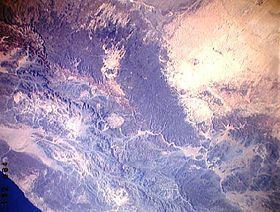Elevation 1,500 m | ||
 | ||
Similar Jabal al‑Lawz, Har Karkom, Mount Catherine, Mount Sinai | ||
Hala-'l Badr (or Hala-'l Bedr / Hallat al Badr, in Arabic: حلا البدر) is a volcano in northwestern Saudi Arabia at 27.25° N, 37.235° E. The volcano is of the cinder cone (or scoria-cone) type, and is on the northeast corner of the Thadra table mountain in the al Jaww basin, an erosional divide between Harrat ar-Rahah and Harrat al 'Uwayrid. Its eruption history is currently unknown, but geological studies have shown that Hallat al Badr erupted some time during the Holocene period, and the most recent lava flows were in the al Jaww basin. Badr has a Volcanic Explosivity Index (VEI) of at least 2, so it is capable of producing an eruption column at least 3 miles (4.8 km) high.
Map of Hala-'l Badr 43962, Saudi Arabia
A number of scholars, including Charles Beke, Sigmund Freud, Immanuel Velikovsky, Eduard Meyer, Martin Noth, and Hermann Gunkel have proposed that the biblical description of devouring fire on Mount Sinai refers to an erupting volcano in the land of biblical Midian. Gunkel writes, "The characteristic Israelite narratives of Yahweh’s appearance in the burning thorn bush (Exod. 3:2), in the burning and smoking Sinai (Exod. 19:9, 20:18; Deut. 4:11), and especially in the pillars of smoke and fire (Exod. 13:21)… can be explained originally from the fact that, in Israel’s earliest belief, Yahweh was the god of the Sinai volcano." This possibility would exclude all the peaks on the Sinai Peninsula and Mount Seir, but would match a number of locations in northwestern Saudi Arabia, of which Hala-'l Badr is the most prominent. Beke renounced his theory that Sinai was a volcano when he learned that Mount Baghir (also "Mountain of Light"), his volcanic Mount Sinai which was located just northeast of the Gulf of Aqaba, was not a volcanic mountain after all.
The equation of Sinai with Hala-'l Badr has been advocated by various scholars and authors, including
In part, Humphreys' argument that Hallat al Badr is Mount Sinai rests on Alois Musils' argument that the itinerary stations given in Numbers 33 lead directly to Badr; he also reports that a volcano in the region erupted in 640 AD, but it is not known exactly which volcano this was. James K. Hoffmeier argues that the route suggested by Humphreys would have put the supposed volcano behind the Israelites at times, not in front. He also notes that the words for "cloud" and "pillar of cloud" appear frequently in Numbers - it covers the mountain, the temple built on top of the mountain, "it occupies the holy of holies in Solomon’s temple" and "Numbers 12:5 specifically refers to God coming down in a pillar of cloud to denounce Miriam’s charges against Moses after departing the mountain of God." Thus "fire and cloud are understood to be vessels of theophany."
